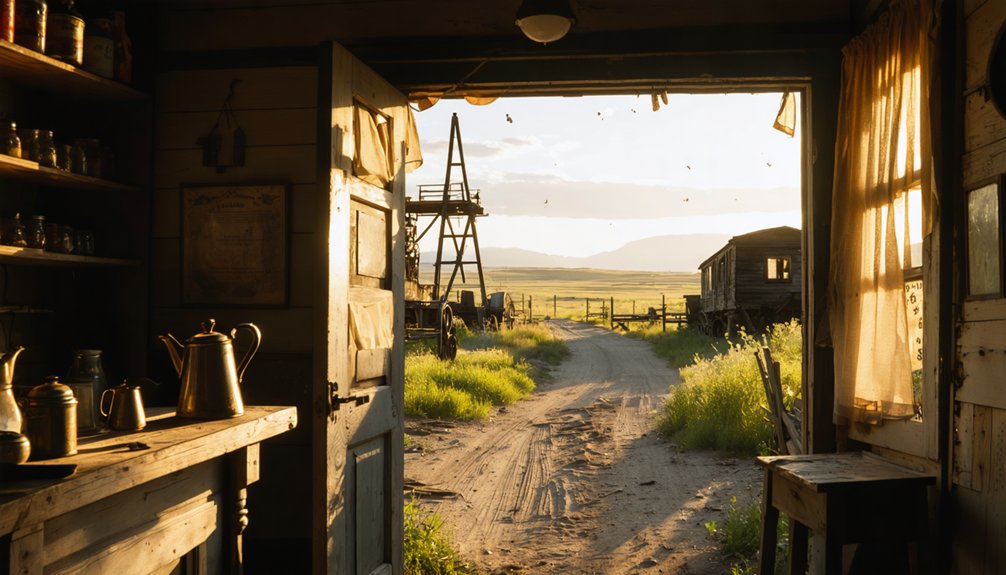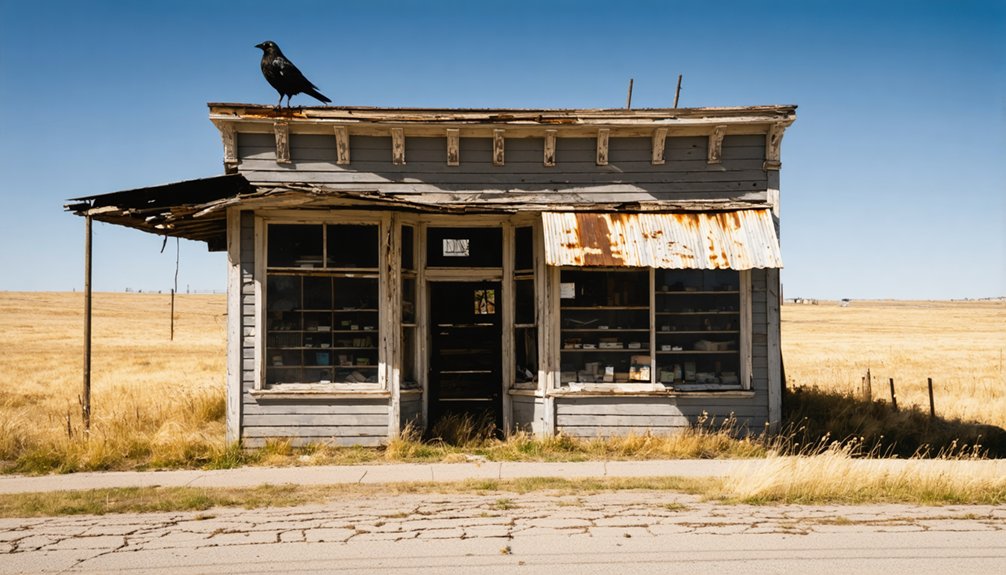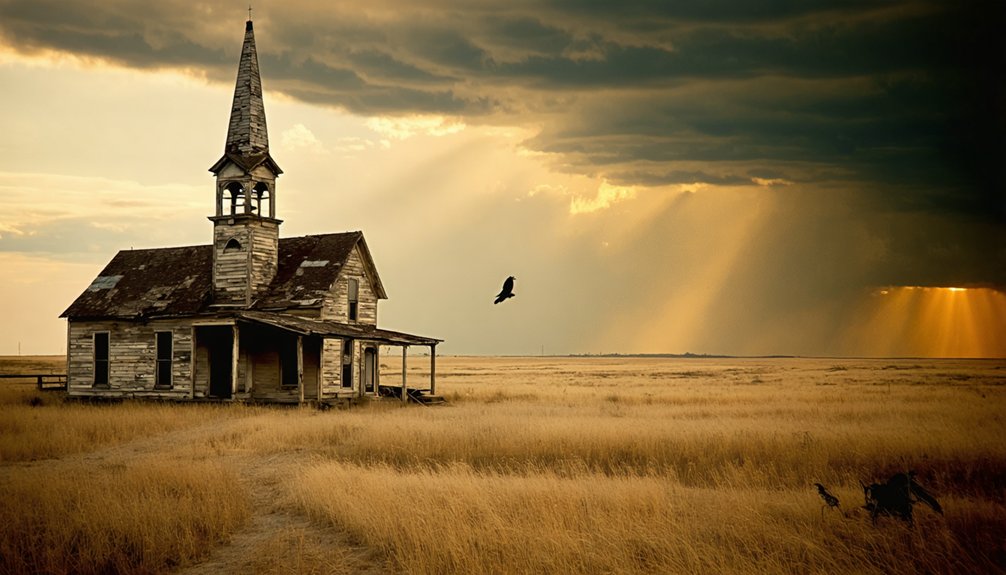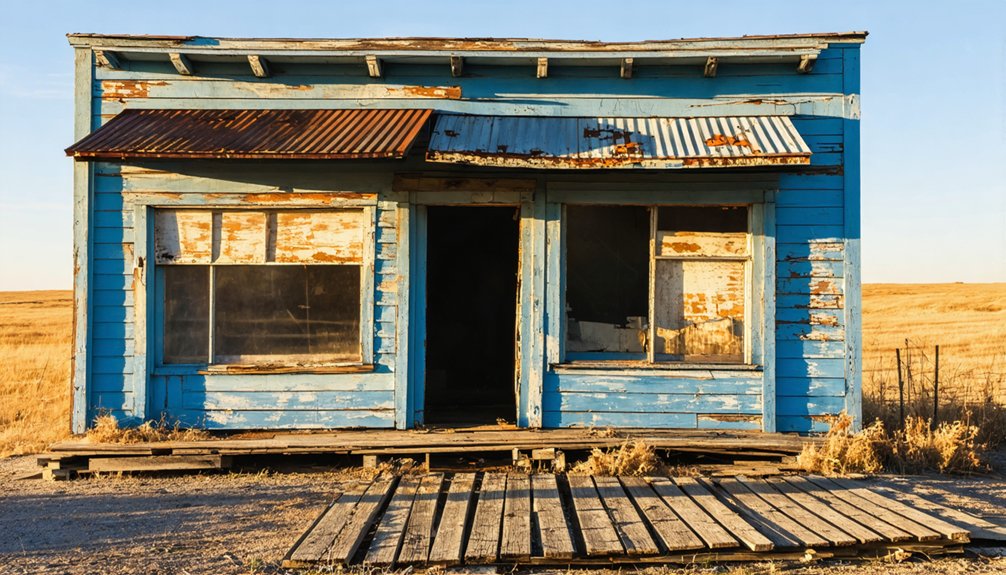You’ll find Snoma, a former Finnish mining settlement in South Dakota’s Black Hills, where a postal error permanently changed its intended name “Suomi” in 1887. The town grew around forty Finnish immigrant families who worked the mines while preserving their cultural traditions through Lutheran services and community gatherings. Though the mining bust led to its abandonment, Snoma’s ruins and cultural legacy offer glimpses into the rich tapestry of Finnish-American mining life.
Key Takeaways
- Originally named Suomi by Finnish immigrants in 1887, a postal service error permanently changed the settlement’s name to Snoma.
- The town declined due to reduced railroad service and Homestake Mine dependence, leading to business closures and population exodus.
- Approximately forty Finnish families established the community, working in mines while maintaining farms and traditional cultural practices.
- The Laestadian Apostolic Lutheran church served as the community’s spiritual center, conducting services in Finnish until the 1950s.
- Only ruins remain today, preserved as historical landmarks that document South Dakota’s mining heritage and Finnish immigrant experience.
Origins of a Postal Mistake
When Finnish immigrants established their South Dakota settlement in 1887, they named it Suomi after their homeland Finland, but a fateful postal service error would permanently alter the town’s identity.
As these pioneering settlers applied to establish their post office, they encountered an unexpected challenge that would reshape their community’s future.
Federal postal officials, unfamiliar with Finnish language and handwriting, misread the name “Suomi” and recorded it as “Snoma” in their official documents.
You’ll find this postal error became cemented in history, as the bureaucratic processes of the time rarely allowed for corrections once names were approved.
While the Finnish immigrants maintained their cultural heritage through their Laestadian congregations and traditions, they’d forever be known to the outside world by this administrative mistake.
Many residents made the 21-mile journey to Deadwood where they found employment in the mines.
Like their counterparts in Calumet who established the oldest Lutheran congregation in America, these South Dakota Finns remained deeply connected to their religious roots.
Finnish Heritage and Community Life
In Snoma’s heyday, you’d find Finnish immigrants preserving their cultural identity through traditional festivals, language preservation, and communal gatherings centered around the Apostolic Lutheran Church.
Like many Finnish settlements across the Great Plains that emerged in the late 1800s, Snoma reflected the period of massive Finnish emigration that began in the 1890s.
The mining life that drew many Finns to the Black Hills region is captured in surviving photographs showing workers at Lead mines, where they’d return seasonally while establishing their farms.
You can trace the community’s vibrant social life through accounts of church socials, community celebrations, and Finnish language services that continued well into the mid-20th century. The community consisted of forty Finnish families who worked tirelessly to establish themselves despite challenging farming conditions.
Finnish Cultural Traditions Preserved
Through vibrant cultural preservation efforts, the Finnish immigrant community of Snoma maintained strong ties to their heritage well into the mid-20th century.
You’ll find evidence of these Finnish traditions in the Laestadian Apostolic Lutheran Church, where services were conducted in Finnish, and in community gatherings that featured distinctive cultural events. Educational programs helped teach younger generations about their Finnish roots.
The community’s dedication to preserving their roots shines through in festivals like Finn Fest, where you can experience traditional Finnish foods and participate in folk games like boot-throwing and wife-carrying contests.
Local families have kept their linguistic heritage alive, with some residents still speaking Finnish and maintaining connections with relatives in Finland. Traditional midsummer bonfire celebrations remain an important part of the community’s cultural calendar.
The cultural legacy lives on through Finnish-language cemeteries, social halls, and museums that continue to celebrate this unique immigrant settlement’s traditions.
Mining Life Through Photos
Historical photographs documenting mining life in Snoma provide glimpses into the challenging existence Finnish immigrants faced while working at the nearby Homestake gold mine.
You’ll discover immigrant struggles reflected in these rare images, showing how Finnish miners adapted their mining techniques from Michigan’s copper country to the Black Hills’ harsh underground conditions.
- Hard rock mining demanded physical endurance, with miners drilling deep beneath the earth while battling heat, poor ventilation, and constant danger.
- Finnish immigrant families often ran boarding houses near the mines, creating small communities that preserved their cultural ties. The forty Finnish families who founded Snoma in 1885 established a tight-knit community that supported each other through the rigors of mining life.
- Working conditions included long hours underground, primitive safety measures, and the ever-present risk of cave-ins or falling debris.
Despite limited photographic evidence, these images capture the determination of Snoma’s Finnish miners to forge a new life in South Dakota.
Community Gatherings and Celebrations
Beyond the hardships of mining life, Finnish immigrants in Snoma built a vibrant community centered around religious and cultural gatherings. You’d find Apostolic Lutheran services conducted entirely in Finnish until the 1950s, with traditional prayers and hymns echoing through homes and churches.
The community’s spirit shone brightest during traditional celebrations at social halls, where Midsummer festivities brought everyone together at venues like Savo Hall.
Today, you’ll still experience this heritage at Finn Fest, where community festivals feature unique contests like wife-carrying and boot-throwing. Local fundraising breakfasts serve up massive Finnish pancakes topped with regional berry syrups, while families maintain their cultural connections through language and customs passed down through generations.
Black Hills Mining Connections
While Snoma’s mining history remained brief, the town’s fate was inextricably linked to the transformative Black Hills Gold Rush that began with Lieutenant Colonel Custer’s 1874 expedition. By the end of 1875, thousands of settlers had already established illegal mining claims in the area.
Mining technology advanced rapidly during this period, as prospectors shifted from simple placer mining to sophisticated hard rock extraction methods. The discovery of gold in French Creek sparked the initial wave of prospectors into the region.
Evolution in mining techniques transformed simple surface extraction into complex underground operations requiring advanced industrial methods.
You’ll find the Black Hills’ economic impact reflected in Snoma’s connection to the region’s mining evolution:
- The change from placer to hard rock mining forced towns to adapt or die as mining methods grew more complex.
- Corporate investments, like George Hearst’s $70,000 Homestake purchase, changed the landscape for small mining communities.
- The development of stamp mills and chlorination plants created a technological revolution that left smaller operations struggling to compete.
Daily Life in a Mining Settlement

As a Finnish settler in Snoma, you’d live in a modest farmhouse while balancing seasonal work at the Homestake Mine with the demanding tasks of running a small farm on poor soil.
You’d rely heavily on your fellow Finnish families for mutual support, sharing labor and resources to survive the harsh South Dakota environment. Local businesses like Harrington and Hargroves Store provided essential supplies for the growing community.
Your days would be filled with physically demanding work, but you’d find comfort in maintaining familiar cultural traditions from Finland, gathering with neighbors for Lutheran services, and speaking your native language within the tight-knit community.
Workers’ Living Conditions
During the peak of Snoma’s mining era, workers endured harsh living conditions that tested their physical and mental resilience.
Housing scarcity plagued the region, forcing many to live in cramped quarters while battling the extreme climate. You’d face constant mining hazards, from dust inhalation to the ever-present risk of accidents underground.
Your daily survival in Snoma depended on three essential factors:
- Finding shelter that could withstand the brutal environment and poor soil conditions
- Managing long work hours while dealing with dangerous mining conditions
- Relying on community support systems, especially within Finnish immigrant groups
The Finnish settlers brought innovative survival techniques, including communal living practices that helped overcome the region’s challenges.
You’d often see families shifting between mining and farming to diversify their income sources and improve their living situations.
Family and Community Bonds
The Finnish immigrant families of Snoma built more than just a mining settlement – they created an intricate web of social bonds that defined daily life in this South Dakota frontier town.
Family dynamics centered around multigenerational households where children participated in daily labor while women managed boarding houses and provided local services. You’d find strong support networks through the Laestadian Apostolic Lutheran church, which served as both a spiritual anchor and social hub since the 1880s.
At the heart of Snoma’s resilience were cooperative labor practices and communal decision-making that helped families weather harsh conditions together.
Extended family ties and kinship networks sustained Finnish cultural traditions, from language gatherings to religious services, creating a tightly-knit community bound by shared immigrant experiences and frontier challenges.
The Path to Abandonment
Mining towns often face uncertain futures, and Snoma’s path to abandonment began with its overdependence on the Homestake Mine’s success. When the mining industry declined, you’d have seen a rapid unraveling of this once-vibrant Finnish immigrant community. Economic factors and geographic isolation accelerated the town’s demise.
The sequence of Snoma’s decline followed a familiar pattern:
- Railroad service reductions cut off crucial transportation links
- Businesses closed as families sought opportunities elsewhere
- Essential services like schools and post offices shuttered, making life unsustainable
You would’ve witnessed the town’s social fabric tear apart as community events ceased and population dwindled.
Without economic diversification and cut off from larger towns like Deadwood, Snoma couldn’t survive the changing times.
What Remains Today

Remnants of Snoma’s once-bustling streets have largely vanished into South Dakota’s pastureland, with only scattered foundations and the Finnish Cemetery marking its former existence.
You’ll find few remaining structures standing today, as time and neglect have reduced most buildings to ruins or mere wall fragments. Nature has reclaimed the town site, with old roadbeds fading beneath wild vegetation and wildlife returning to the quiet landscape.
The Finnish Cemetery stands as the most significant surviving landmark, its weathered tombstones preserving the stories of Snoma’s past residents.
Weathered gravestones in Snoma’s Finnish Cemetery stand as silent storytellers, keeping alive memories of those who once called this place home.
While you won’t find maintained roads or modern infrastructure, occasional artifacts from the mining era surface near the site. The cemetery’s ongoing upkeep by local groups guarantees that at least one piece of Snoma’s cultural heritage endures.
Legacy in South Dakota History
Beyond its physical remains, Snoma stands as a symbol to South Dakota’s vibrant mining heritage and immigrant story. Its legacy continues to educate and inspire those interested in the state’s dynamic past.
You’ll find Snoma’s influence woven into the broader tapestry of South Dakota history in three significant ways:
- Cultural contributions from Finnish immigrants who created a tight-knit community, enriching the Black Hills region’s ethnic diversity.
- Economic impacts through its connection to the Homestake Mine, demonstrating how small mining towns fueled South Dakota’s industrial growth.
- Historical significance as a case study of boom-and-bust cycles that shaped the state’s development.
Today, Snoma’s story helps you understand the forces that built South Dakota, from immigrant determination to the transformative power of the gold rush era.
Preserving the Town’s Memory

Modern efforts to preserve Snoma’s memory combine both physical conservation and cultural documentation.
You’ll find that preservation focuses on protecting remaining ruins and foundation traces, while preventing vandalism through strategic fencing and controlled access. The South Dakota State Historical Society maintains essential records of the town’s history through journals, archives, and property documents that tell Snoma’s story.
Like other ghost towns in the region, Snoma’s legacy lives on through community memory shared at regional reunion events, where former residents’ descendants gather to exchange stories and photographs.
Regional gatherings keep Snoma’s spirit alive as descendants share treasured memories and photos of their ghost town heritage.
While tourism helps raise awareness about ghost town preservation, you’ll need to respect private property boundaries and safety concerns when visiting.
Digital documentation, including virtual tours and documentaries, allows you to explore Snoma’s history without disturbing the physical site.
Frequently Asked Questions
Are There Any Known Photographs of Snoma During Its Active Mining Period?
You won’t find any historic photographs from Snoma’s mining period. While nearby towns like Deadwood and Lead have extensive records showing mining equipment, there’s no photographic evidence of Snoma’s operations.
What Was the Peak Population of Snoma at Its Height?
Like many settlements that vanished into Western legend, you’ll find no exact records, but based on similar mining boom towns nearby, Snoma likely peaked between 50-100 residents before population decline set in.
Did Snoma Have Its Own School or Church Buildings?
You won’t find evidence of dedicated school or church buildings in historical records. With only 27 residents at its peak, the town’s infrastructure focused on mining rather than formal educational or religious facilities.
Were There Any Notable Crimes or Incidents Recorded in Snoma?
You won’t find any documented crimes or mysterious disappearances in historical records from Snoma. The small Finnish settlement’s brief existence left behind minimal evidence of criminal activity or notable incidents.
Can Visitors Legally Access and Explore the Snoma Site Today?
You’ll need to verify property ownership and get permission first, as access regulations aren’t clearly defined. While the Finnish cemetery’s open for visits, site preservation laws protect against disturbance of historic features.
References
- https://www.sdhspress.com/journal/south-dakota-history-2-2/some-black-hills-ghost-towns-and-their-origins/vol-02-no-2-some-black-hills-ghost-towns-and-their-origins.pdf
- https://www.sdpb.org/rural-life-and-history/2023-08-21/some-black-hills-ghost-towns-and-their-origins
- https://www.youtube.com/watch?v=_0WNYsFLSLA
- https://www.powderhouselodge.com/black-hills-attractions/fun-attractions/ghost-towns-of-western-south-dakota/
- https://icatchshadows.com/okaton-and-cottonwood-a-photographic-visit-to-two-south-dakota-ghost-towns/
- https://www.blackhillsbadlands.com/blog/post/old-west-legends-mines-ghost-towns-route-reimagined/
- https://en.wikipedia.org/wiki/List_of_ghost_towns_in_South_Dakota
- https://finnishnotdone.com/2013/08/22/finns-in-deadwood/
- https://b1027.com/south-dakota-has-an-abundance-of-ghost-towns/
- https://www.sdhspress.com/journal/south-dakota-history-2-3/valentine-scrip-the-saga-of-land-locations-in-southern-dakota-territory-originating-from-a-mexican-land-grant/vol-02-no-3-valentine-scrip.pdf



